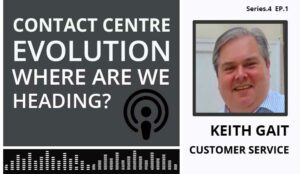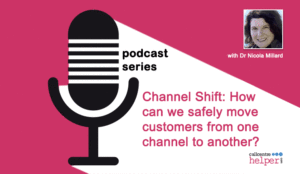The Contact Centre Podcast: Series 4 Episode 1
Keith Gait shares great insights into the current changes that are going on within contact centres and makes some interesting predictions into the future of the industry.

In our conversation, we also discuss how service levels are shifting, why organizations need to focus more on supporting advisors with the right knowledge, as well as other trends like AI and customer emotion.
To listen to the podcast directly from this web page, just hit the play button below:
The Contact Centre Podcast – Episode 19:
Contact Centre Evolution: Where Are We Heading?
This podcast was made possible by our sponsor, Genesys.
Podcast Time Stamps
- 3:00 – Homeworking
- 4:13 – Service Levels
- 5:53 – Knowledge Sharing
- 8:02 – The Threat to Outbound
- 9:43 – Future Contact Centre Trends
- 13:30 – AI
- 17:50 – CSAT and NPS
- 18:39 – Keith’s Success
Here is a Transcript to the Podcast
Charlie Mitchell: We always hear of phrases and taglines like, the best service is no service, and it seems like many organizations are trying to bypass the contact centre with self-service and automation. So as organizations evolve, will we still need call centres?
Keith Gait: Yes, we will. Yes, we do. But for much more complex issues. Most of the high-volume, low-complexity interactions have now moved online. So in many operations now people are calling because they haven’t been able to self-serve or do what they need to do online. This presents a problem for the industry as it grew up with lower-paid, lower-skilled staff.
Keith: But as the complexity increases, so will the skills and qualities needed because frontline staff are not stupid, they know the market rates being paid; the better ones will seek to be better rewarded. This will either be by internal promotion or they will leave. Perhaps more importantly, how do we position working in a call centre as a great career choice to attract the type of talent we need for the work of the future?
Charlie: Yeah, I think that’s a very interesting question to consider and one that many call centres are already asking themselves and already acting on. In fact, I’m seeing some contact centres look to homeworking to increase their recruitment pool. Is this a trend that you expect see more of as well with call centres looking to attract a different type of talent?
Keith: Well, homeworking has been about for many years now and still doesn’t seem to have the mainstream take-up that we all expected it to. I wonder what the reasons are for this. It shouldn’t be about technology any more. So many systems are cloud-based and home network speeds are so much better than they were. So maybe it’s cultural.
Keith: Homeworking doesn’t suit everyone. Call centres are places with lots of vibe, lots of atmosphere and lots of great people, lots going on, and a lot of people prefer being with other like-minded people. There are not a lot of people that like or enjoy working in isolation. So maybe that’s the reason. Maybe it’s also cultural on behalf of the employers too. There are still too many places that think if they can’t see you then you’re not working. We have to get away from that.
Charlie: I think that’s interesting. I mean I’ve myself done a bit of homeworking in the past, and it was just for a few weeks and I thought at the start, “Oh this is great.” But then after a few days, it started to become a different feeling like, “Oh, it’s a bit of social isolation,” as you say. So I think that’s a very interesting point to consider.
Charlie: So homeworking is something that planning teams will likely have to think about more in the future. I think another thing that they’ll have to think about too is service level. I mean for so long we’ve stuck to that traditional 80% of calls answered in the 20 seconds mark, but we’re now seeing that change in our own research at Call Centre Helper. I mean we’re seeing groups of contact centres move to an 80/40 mark now, and also a 90/10, so in two separate directions. But how do you see service level as a metric evolving as we move forward in time?
Keith: Well, you’re absolutely right about that. The service level required depends very much on the organization that you’re dealing with. I worked at a mobile phone company running their large call centre estate and 80/30 was perfectly acceptable, but equally, when I ran the NHS and the ambulance service, we needed 95 in 10 because it wasn’t until we answered that phone call that we knew if it was a baby turning blue, a heart attack or an ingrown toenail. So it has to reflect the business that you’re in.
Keith: I was also reflecting recently on what I was working on at the start the last decade, given that we’ve just started the new decade, and it was still all about service levels and percentage of calls answered in 20 seconds. You’re right, that era has passed now. That’s partly because the planning teams are so skilled now the forum have done great work to professionalize and share and develop best practice here, but also because customers have demanded, and a lot of businesses have recognized, that the quality of the resolution is what matters most. The ability to resolve the customer’s issue quickly and without effort repeating or duplicating is what’s needed most now.
Charlie: Yeah. I think from what you’ve just said that I sense that as the contact centre evolves, we need to start thinking more about knowledge-sharing systems that we can use to support advisors, because I mean, as you say, resolving customers’ issues quickly and without effort is something that we have to address not only through self-service but in the contact centre as well. But do you think that this is something contact centres are struggling with even now in terms of putting the right knowledge-sharing systems in place?
Keith: They definitely are. In the last three organizations that I ran the biggest problem with customer contact is the knowledge system. So it’s the biggest problem I’m seeing in many places at the moment with the increasing complexity of customers’ requirements when they’re calling and the ever-increasing levels of customers’ expectations. They expect you to have the information to hand right away.
Keith: The agent is only as good as the information they have. It’s not uncommon for the customers to be more informed than they are. So this is a key area for me for the next few years. My plea goes out to the IT industry to fix the issues with the knowledge systems. The added bonus is, if we do fix knowledge systems, then that information can also be deployed into the website and social media, meaning more customers can find the answers and information they need without the need to call in. So it’s a massive win–win for everybody.
Charlie: Yeah. I think it’s interesting. As you were saying that, I was thinking about the knowledge-management systems that many call centres still don’t have in place, which we may consider in some organizations to be very fundamental things. I mean such as the Knowledge Champions initiative or having knowledge templates so advisors can fill that in, so it’s easy to know what they say to the customer and what instructions that they have to do. And just having these simple knowledge-management techniques in place is something that many businesses are still lacking. So I thought it was very interesting insight that you just shared.
Charlie: Knowledge is a very interesting area in general. I mean, according to our own research, contact centres are looking much more to invest in knowledge-based technology in the future, which I think is a very interesting point that we’ve taken from our latest research. Another interesting point that we also took from this – sorry it’s moving quickly from one topic to another now – is that contact centres are massively cutting back on their outbound operation too. I was just wondering why you think this may be and if you expect this trend to continue?
Keith: I do expect it to continue. Outbound is becoming much more complex, multiple layers of compliance needed and operators will need to move to a much more relational dynamic rather than seeking new customer acquisition through that channel. Well, we’ve been speaking about this for a few years now, so it’s those that have planned ahead and have adapted that are going to be successful.
Keith: There was a great article recently by Steve Sullivan in the DMA about this, exploring the many complex layers of compliance needed for it to succeed. It showed that volume of outbound activity has halved in the last 15 years and now less than one in five UK contact centres are taking up an activity.
Charlie: I think that’s a thing… that’s a very surprising statistic there that halving in 15 years is something … I knew it was going down, but to that extent, that’s quite remarkable. It’s especially interesting when you consider that outbound can still work for initiatives like proactive customer service and contacting the customer before they even realize that there’s a problem and telling them what you’re going to do about it so it stops them from calling you.
Charlie: I mean these are initiatives that a lot of vendors are selling their kind of tools around, their proactive tools, but the fact that outbound is continually decreasing goes against the notion that we’re going to see more of this proactivity in the near future at least. I think this is maybe what is keeping outbound alive for the moment is some sort of proactivity and that kind of notion going towards the future. But I was just wondering what other trends like proactive customer service you expect to rise in the near future?
Keith: I think there’s two things really. One is speed, and again it comes back to the knowledge system. One of the issues with the knowledge system is getting the right information into it, but the other issue is getting the information into it quickly enough, because again you do have the situation sometimes where customers are more informed than the agent on the phone purely because of the lack of timely information.
Keith: The other big thing is AI, but is it just the latest fad? Gamification, wearable tech, big data – they’re all buzzwords I’ve heard at various conferences the last few years, all of which have faded away and come to nothing. Is AI going to go the same way or is it here to stay? Time will tell, but my view is that AI is here and then will develop further. But businesses need to be very careful about how they deploy it and the vendors and consultants need to be careful about how they promote and position its benefits.
Keith: My plea is for this not to be another hammer to simply reduce costs and headcounts, but to be used to enhance the service a customer receives and not be the 21st century’s version of the IVR issues of dead ends and loops that drive customers mad, that mean they can’t get their issues dealt with.
Keith: The final thing is customer emotion. Years ago we focused very much on CSAT, a measure of satisfaction. Then it was all about NPS, a measure of loyalty. Now it’s about driving towards emotion, and there’s lots of very clever people trying to work out what that actually means and how or if you can actually measure it.
Charlie: I think there’s so much to pick through what you just said. I mean I really agree heavily with that point about we’re still seeing IVR issues however many years after these technologies had been brought to the contact centre. So it’s interesting to see how AI will develop into the future, and hopefully we don’t see those similar mistakes repeat themselves.
Charlie: The emotion again is a very interesting thing. We’re hearing a lot at the moment at Call Centre Helper about emotions and forming memories around the customer experience and including them in trying to build in emotional intelligence into the call centre, and I think it’s two very interesting topics.
Charlie: But one other that I’d love to get your opinion about on these continuing trends is the future of the phone channel. While the contact centre will certainly live on from one of the key points that we discussed earlier, do you think the phone channel will remain the number-one channel in the coming years?
Keith: I believe it will. There’s some great research from Nicola Millard at BT back in the last year, showing that the phone still accounts for over two-thirds of transactions and it’s predicted to remain so. My personal view is that whatever technology is available, the customer will choose what is most convenient for them. We have to be where the customers are.
Keith: So the choice of channels will inevitably increase, but we must have two-tier customer service. There’s still and always will be a place for the phone, and many people have no alternative, and we have to continue to provide great service to all the customers, not just those that are more tech-savvy.
Charlie: Yeah. I think that again is another very interesting point. I mean Nicola from BT, we’ve had on a podcast before and she has lots of great new research, and I think that’s another really interesting point. I mean we’re all on a digital journey, I guess, and too often I think people think young people want self-service and older people want these new-fangled digital channels.
Charlie: I think everybody will still use the phone for those really emotional issues, and we shouldn’t think about it in such a separated way, and I really think that’s a very interesting point as well. But out of the trends that we’ve discussed so far today, we’ve already talked about AI and emotion, and homeworking, which do you think will have the most profound impact on the contact centre in the coming years?
Keith: I think it’s going to be AI, and sadly that’s because I think a lot of finance directors will see it as a silver bullet to finally reduce headcount costs and drive more people to self-serve, reducing contact volumes. We as an industry have to articulate strongly that this should be another channel for those that want to use it. If we force people into it, the damage to customer experience is going to be huge.
Charlie: Yeah, it’s one of those… I mean, we saw lots of contact centres implement chatbots quite early on and maybe not get those quite right before putting them in front of customers. I think as long as we think about it more systematically. I just want to ask you one quick thing around this AI topic. Do you think that it will be things like chatbots that brands look to implement or do you think it would be other things, maybe a bit more along the lines of automation?
Keith: Everybody is still trying to work it out. I first had discussions around AI at a contact centre I was running back in 2012, and organizations are still trying to work it out eight years later. So it’s not gained a lot of mainstream traction yet. It’s still a very niche thing for a very small number of people. So I think we’ve got a long way to go.
Keith: Again, coming back to another topic, the AI is only as good as the knowledge that we put into it; it can’t guess. So it comes back to having timely, relevant knowledge available, and if we can get that then we can start to deploy that.
Charlie: I think that’s interesting, and that knowledge point… I mean we talked about knowledge sharing earlier, very much getting the knowledge to the agents. But if you can connect your different departments together and you have a flow of knowledge, that would work really well to feed your AI systems as well, so you can manage and use data to your advantage. I think that’s a very interesting point. Quickly, I know earlier we mentioned emotion, I just want to quickly drop back in on that. Do you think this will have a really big impact on the contact centre in the coming years?
Keith: I think it will for the more mature organizations, those that have been running contact centres and already have great customer service reputations. I think the next step is to move on to customer emotion. For other organizations, the one I’m working with currently, we’re a long way behind. We’re still getting to CSAT and NPS. So emotion is a long way down for us.
Keith: It’s very different, again, according to the business that you’re running. If you’re a big retailer selling a sofa for three and a half thousand pounds, emotion and connectivity and how that person feels about it is very important. But me at a bus company selling a ticket for £1.85 it’s much more difficult to do.
Charlie: Yeah. Yeah, I think that’s a very interesting point. I think one thing that a lot of brands are struggling to do with emotion, which you can do with satisfaction and net promoters, say, is to find out how to measure it as well. I know there are ways to measure it as a metric through asking questions about the experience and categorizing their responses and positive and negative words and using that as a kind of a formula of how many positive words do I get and how many negative words and kind of using that to add to a mathematical equation, which I know is being used.
Charlie: But I think the more sophisticated way is through speech analytic systems and sentiment analysis. Is this anything that you’ve seen work before and do you think that this is the future?
Keith: I think it is. Again, there’s a lot of very, very clever people working on that and a lot of very clever people working out how to do it and how best to deploy it. Some organizations are obviously a lot further down the road with the numbers on that. Others are still trying to battle with what it means. Then again, it would be more relevant for some businesses than others. But again, speech analytics, we’ve been talking about this for eight, nine years now and it’s still not mainstream.
Charlie: Yeah, that’s a very true point. It’s kind of interesting. I guess we’ll see as time unfolds how emotion is, if it still does actually cling to organizations within the next five or ten years, and if it will take longer, and how more traditional metrics, maybe like customer satisfaction and first contact resolution even, whether they’ll stay the kind of strongholds of the customer metric scene.
Charlie: Is there anything else in terms of customer metrics that you think will possibly change within a few years? Do you think that customer satisfaction will still be number one?
Keith: I think CSAT and NPS is going to be here for a long time. Organizations are getting better at using it, and customers are used to deploying it. I think the next stage for that, and it’s something that we are doing at Stagecoach, which we’ve implemented there. We’ve got our feedback system that’s getting into the closed-loop. It’s digging into the verbatims and categorizing those and understanding exactly how we can adapt our service based on what people are really saying. That’s the next level.
Charlie: Yeah, I think it’s interesting. We were talking a little bit about NPS before we started going live, and I know that you’ve seen some really great NPS scores at Stagecoach. How you’ve managed to increase by almost 30 points within less than a year. What do you put this down to and what do you think can maybe different organizations learn from your approach?
Keith: What we sought to do is to change our frontline culture. Most transport organizations focus on the bus or the train. What we’ve tried to do is work with all our frontline staff. It’s the person on the bus that matters, not the bus itself. So we’ve done a huge amount of culture change and really identified fairly early on that the culture was unwritten and it was happening at the depots.
Keith: So we have call-centre levels of attrition in bus driver population. So we train all our bus drivers and they’re taught how to drive the bus safely and they’re taught about customer service, but they would get back to depot and the culture would emerge fairly quickly that the only thing that mattered was getting the bus running to its timetable.
Keith: No one spoke about it, no one trained them on that. No one measured on that. But that’s the culture that emerged, and that’s what we’re trying to change, and that’s what we’ve been able to work on very heavily with our partners over the last six to nine months and we’re starting to see some great results from doing that.
Charlie: Yeah, we obviously, we talked about yourselves now, very impressive. I think culture is something that we haven’t really spoken about so far, which is, I think, going to be a very interesting trend as we move into the near future, and how we motivate and engage our employees and maybe make sure that we start setting the right expectation and we don’t just follow processes that have maybe been there for years before that nobody really talks about.
Charlie: I think this is one problem that we have in call centres, especially where people get promoted from lower ranks, but they don’t try and change things. They just try to replicate the job of the person before them, because they think, “Oh, they might be my mentor. I’ll just try and do the same job that they did.” So the evolution period for call centres maybe isn’t as quick as we would hope it would be. Do you think that maybe in looking into culture and employee engagement is going to be a really major aim for many organizations within the next five to ten years?
Keith: I think that’s huge, and one of the reasons for it is that customers’ expectations are moving much more quickly than the ability of the call centre to adapt.
Charlie: Yeah. Yeah, it’s very interesting. As you say, I think the expectations of workers as well maybe is something that’s particularly interesting. Do you think that this millennial generation that’s moving into the call centre right now have much different expectations as well as customers?
Keith: Oh, they definitely do. They definitely do. I haven’t seen any research specifically about attrition levels from the under-25s. It would be very interesting if someone did that piece of work to see where the attrition levels are and what the retention levels are like with that generation. They’re a very aspirational generation. Rightly so. The idea of a job for life went a long time ago. So it’ll be interesting to see how that plays out.
Charlie: Yeah. Yeah, I think it’s interesting. I think the average worker now coming through into the call centre would expect to have five other jobs in their lifetime. I think that was a stat that I heard recently, and I think that’s a very interesting point to end on. I mean we spoke about so many great topics today: AI, emotion, workforce management in terms of service level and homeworking as well. There’s lots more great insights that I’m sure that you have to share with our audience. So where can our readers go if they want to find out any more of your insights? Are you on any social media platforms like LinkedIn?
Keith Gait: Yes, I’m on LinkedIn. Keith Gait on LinkedIn. Keith Gait MBA.
Charlie: Excellent. Great stuff. Thanks for joining us today, Keith.
Keith: Thank you.
Author: Jonty Pearce
Reviewed by: Robyn Coppell
Published On: 23rd Mar 2020 - Last modified: 26th Sep 2025
Read more about - Podcasts, Genesys, Keith Gait, Podcast



















